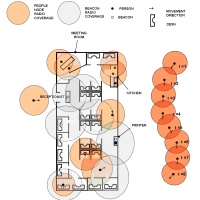
Accurate localization of people in indoor environments is an important need for many applications (e.g. resource management, localization of first responders). Numerous indoor localization solutions using radio, ultrasound and infrared technologies have been proposed over the past few years. Among all of them, radio wireless techniques based on Radio Signal Strength (RSS) provide an inexpensive and simple way to track and locate people indoors. However, these techniques are not very accurate and the accuracy is directly related to changes in the building topology .
In this work, we investigate a new indoor localization system based on short-range radio technologies (Bluetooth, BT) and learning socio-temporal patterns. The network will consist of two kinds of radio nodes: static devices (anchors) and the mobile nodes (people tracked). The main proposed novelty is an extension of Multidimensional Scaling (MDS) called Dynamic Weighted MDS (DWMDS). DWMDS finds a two dimensional embedding (x and y coordinates of the people/devices) of the data consistent with a social mobility model. DWMDS will infer the unknown position of nodes from sparse connectivity matrices among the radio devices at each time. Preliminary experiments show the effectiveness and robustness of the proposed algorithm.
current head
current contact
past staff
- Jose Maria Cabero
